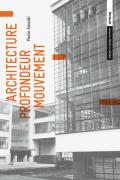Architecture Profondeur Mouvement

This text is not a story of the perceived forms, in a frame or in a three dimensional space, but of the way they are perceived. Starting from the principle that the space exists primarily as a place where the eye moves, we go into the shape of the eye itself. Denying the approaches of traditional history of art and architecture, this book aims to highlight how painting, architecture, urbanism and landscape is experienced and consumed by the viewer. What emerges is a new and not obvious idea: there is a perceptual structure, intrinsic to the object or architectural framework althought not coinciding with the geometric shape, that orientates the view. The work of art stimulates the viewer to consume it in a certain way, creating him with its intent and its expectations. So the space is understood as an emergent property of the sight. Moreover, throughout history, the viewer is physically and mentally located both inside and outside of space, two positions referring to two philosophical antinomies: Plato on one side and Aristotle on the other. The vast historical landscape outlined in this book shows that every age perceives the world differently.